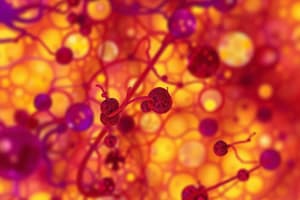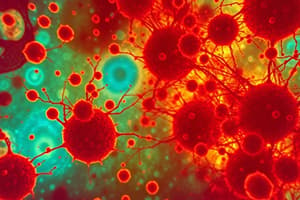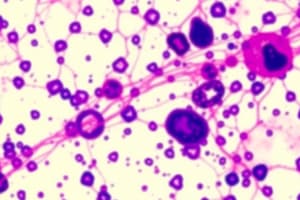Podcast
Questions and Answers
What is the primary purpose of using stains in biological material?
What is the primary purpose of using stains in biological material?
- To alter the chemical composition of cells
- To improve visibility and contrast (correct)
- To kill microorganisms
- To create a permanent record of organisms
What constitutes a dye in contrast to a stain?
What constitutes a dye in contrast to a stain?
- Only organic compounds
- A general-purpose coloring agent (correct)
- A specific stain for nucleic acids
- Impermeable to biological materials
Which component of a stain provides the ability to bind to biological tissues?
Which component of a stain provides the ability to bind to biological tissues?
- Mordant
- Auxochrome (correct)
- Staining buffer
- Chromophore
What type of stains are primarily used for staining bacteria?
What type of stains are primarily used for staining bacteria?
What is the role of a mordant in staining techniques?
What is the role of a mordant in staining techniques?
What is a key characteristic of differential staining techniques?
What is a key characteristic of differential staining techniques?
What is the function of a decolorizer in staining?
What is the function of a decolorizer in staining?
Which of the following stains can be classified as a simple staining technique?
Which of the following stains can be classified as a simple staining technique?
What is the primary stain used in the Gram staining procedure?
What is the primary stain used in the Gram staining procedure?
Which component is retained by Gram-positive bacteria during the decolorization step?
Which component is retained by Gram-positive bacteria during the decolorization step?
What color do Gram-negative bacteria appear after the entire Gram staining procedure?
What color do Gram-negative bacteria appear after the entire Gram staining procedure?
What is the function of the iodine solution in the Gram staining process?
What is the function of the iodine solution in the Gram staining process?
Why can some Gram-positive bacteria stain as Gram-negative?
Why can some Gram-positive bacteria stain as Gram-negative?
What additional requirement is used for the Gram staining procedure?
What additional requirement is used for the Gram staining procedure?
What differentiates acid-fast bacteria from other bacteria during staining?
What differentiates acid-fast bacteria from other bacteria during staining?
What constitutes the outermost layer of the Gram-negative bacteria?
What constitutes the outermost layer of the Gram-negative bacteria?
What property of Mycobacteria allows them to retain the acid fast stain?
What property of Mycobacteria allows them to retain the acid fast stain?
Why do shorter chain mycolic acids result in weak acid-fast staining?
Why do shorter chain mycolic acids result in weak acid-fast staining?
Which staining method uses a hypertonic solution to demonstrate bacterial capsules?
Which staining method uses a hypertonic solution to demonstrate bacterial capsules?
What visual characteristic distinguishes endospores under the light microscope?
What visual characteristic distinguishes endospores under the light microscope?
What is the role of malachite green in the Schaeffer-Fulton method?
What is the role of malachite green in the Schaeffer-Fulton method?
Which method for endospore staining requires heating to allow the primary stain to penetrate?
Which method for endospore staining requires heating to allow the primary stain to penetrate?
What color does the capsule appear when stained using Hiss’ method?
What color does the capsule appear when stained using Hiss’ method?
What is the primary function of a bacterial capsule in diagnostics?
What is the primary function of a bacterial capsule in diagnostics?
What is the primary characteristic of a simple staining method?
What is the primary characteristic of a simple staining method?
What occurs during the direct (positive) staining process?
What occurs during the direct (positive) staining process?
Which of the following is true about indirect (negative) staining?
Which of the following is true about indirect (negative) staining?
What is one of the key reasons for fixing a smear in the staining process?
What is one of the key reasons for fixing a smear in the staining process?
What distinguishes Gram-Positive bacteria from Gram-Negative bacteria in Gram's staining procedure?
What distinguishes Gram-Positive bacteria from Gram-Negative bacteria in Gram's staining procedure?
Which aspect of the bacterial cell is primarily responsible for differentiating between Gram-Positive and Gram-Negative bacteria?
Which aspect of the bacterial cell is primarily responsible for differentiating between Gram-Positive and Gram-Negative bacteria?
Which dye is typically used in direct (positive) staining methods?
Which dye is typically used in direct (positive) staining methods?
What happens to bacteria during the fixation process?
What happens to bacteria during the fixation process?
Flashcards
Gram-Positive Bacteria Cell Wall
Gram-Positive Bacteria Cell Wall
Thick, dense, relatively non-porous cell wall.
Gram-Negative Bacteria Cell Wall
Gram-Negative Bacteria Cell Wall
Thin cell wall with a lipid-rich outer membrane.
Gram Staining
Gram Staining
A four-step procedure to differentiate bacteria based on cell wall structure.
Gram Staining Procedure
Gram Staining Procedure
Signup and view all the flashcards
Gram Staining Primary Stain
Gram Staining Primary Stain
Signup and view all the flashcards
Gram Staining Mordant
Gram Staining Mordant
Signup and view all the flashcards
Gram Staining Decolorizer
Gram Staining Decolorizer
Signup and view all the flashcards
Acid-Fast Bacteria
Acid-Fast Bacteria
Signup and view all the flashcards
Simple Staining
Simple Staining
Signup and view all the flashcards
Direct/Positive Staining
Direct/Positive Staining
Signup and view all the flashcards
Indirect/Negative Staining
Indirect/Negative Staining
Signup and view all the flashcards
Gram-Positive Bacteria
Gram-Positive Bacteria
Signup and view all the flashcards
Gram-Negative Bacteria
Gram-Negative Bacteria
Signup and view all the flashcards
Smear Fixation
Smear Fixation
Signup and view all the flashcards
Importance of Fixation
Importance of Fixation
Signup and view all the flashcards
Staining in Microbiology
Staining in Microbiology
Signup and view all the flashcards
Dye vs. Stain
Dye vs. Stain
Signup and view all the flashcards
Stain Composition
Stain Composition
Signup and view all the flashcards
Basic Stains
Basic Stains
Signup and view all the flashcards
Acidic Stains
Acidic Stains
Signup and view all the flashcards
Mordant
Mordant
Signup and view all the flashcards
Differential Staining
Differential Staining
Signup and view all the flashcards
Acid-fast staining of Mycobacteria
Acid-fast staining of Mycobacteria
Signup and view all the flashcards
Acid-fast bacilli in sputum
Acid-fast bacilli in sputum
Signup and view all the flashcards
Capsule staining
Capsule staining
Signup and view all the flashcards
Capsule, virulence factor
Capsule, virulence factor
Signup and view all the flashcards
Negative staining (capsule)
Negative staining (capsule)
Signup and view all the flashcards
Endospore Staining
Endospore Staining
Signup and view all the flashcards
Schaeffer-Fulton stain
Schaeffer-Fulton stain
Signup and view all the flashcards
Mycolic acids in Mycobacteria
Mycolic acids in Mycobacteria
Signup and view all the flashcards
Study Notes
Stains & Staining
- Staining is used to improve visibility of organisms, differentiate morphological types, diagnose diseases, and ensure purity of culture.
- It helps observe structures like flagella, capsules, and endospores.
Stains and Dyes
- A dye is a general-purpose coloring agent, whereas a stain targets biological material.
- A stain is an organic compound, containing a benzene ring, chromophore (imparts color), and auxochrome group (allowing ionization and binding to fibers/tissues).
Requirements for Staining
- Most bacterial stains are basic; nucleic acids attract positive ions (e.g., methylene blue, crystal violet).
- Acidic stains target the background.
- Mordants are chemicals forming insoluble complexes with stains, allowing deeper penetration into cells (e.g., Gram's iodine, phenol).
- Accentuators enhance stain selectivity and intensity (e.g., potassium hydroxide in Loeffler's methylene blue).
- Decolorizers remove excess stain in indirect staining (e.g., ethanol in Gram's staining).
Types of Staining Techniques
- Simple staining: uses a single stain, staining everything the same color.
- Direct/positive staining: stains the specimen.
- Indirect/negative staining: stains the background.
- Differential staining: uses two contrasting stains, allowing differentiation of groups.
- Separation into groups: Gram stain (differentiates Gram-positive and Gram-negative bacteria), acid-fast stain, etc.
- Visualization of structures: Flagella stain, capsule stain, spore stain.
Simple Staining
- Simple staining uses a single dye that doesn't differentiate between organism types.
- All parts of the specimen are stained with the same color.
- Simple stains are used to stain whole cells or specific cellular components.
- The types of simple staining are: direct (positive) and indirect (negative).
Direct Staining (Positive Staining)
- A simple staining technique that stains bacterial cells in a single color.
- Many bacterial stains are basic chemicals. These basic dyes react with negatively charged bacterial cytoplasm, directly staining the organism.
- Examples: methylene blue, crystal violet, basic fuchsin.
Indirect Staining (Negative Staining)
- In this process, the background is stained instead of the cells.
- An acidic dye (e.g., nigrosin, Indian ink) is used, which repels negatively charged bacteria and deposits around them.
- This leaves the organism itself colorless or transparent.
Staining: General Technique
- Smear preparation: spreading a thin film of specimen over a slide.
- Air drying.
- Heat fixing: passing the slide through a flame to kill organisms and attach them to the slide, making them more receptive to stains.
- Staining (different stains are used depending on the particular experiment).
Importance of Fixing Smears
- Fixation kills organisms, ensuring they adhere to the slide.
- It alters the organisms to promote stain uptake.
Differential Staining: Gram Staining
-
Gram staining differentiates Gram-positive and Gram-negative bacteria.
-
Gram-positive bacteria retain a violet-iodine complex, while Gram-negative bacteria decolorize and stain pink.
-
Gram staining is the starting point of bacterial identification.
-
Gram-positive bacteria have thick, strong cell walls, retaining crystal violet.
-
Gram-negative bacteria have thin cell walls and outer membranes, losing crystal violet and taking up safranin.
-
Gram staining reagents: crystal violet, iodine solution, decolorizer (ethanol), safranin.
Acid-Fast Staining
- Acid-fast bacteria resist decolorization with acid-alcohol.
- This is due to their waxy cell walls (containing mycolic acids), which resist decolorization.
- The stain (e.g., carbolfuchsin) is forced into the cells using heat.
- The acid-fast stain technique is particularly useful in identifying Mycobacterium species.
Special Staining: Capsule Staining
- Bacterial capsules are non-ionic, so neither acidic nor basic stains adhere effectively.
- Capsule staining uses negative staining (e.g., nigrosin, India ink) or special staining methods to demonstrate the capsule.
- Methods for capsule staining include Hiss method.
Special Staining: Spore Staining
- Spores resist staining.
- Special methods (e.g., Schaeffer-Fulton) are employed, using a primary stain (malachite green) that is forced into the spore by heating.
- After decolorization, the vegetative cells are counterstained. This isolates the spores, which are stained green, from the stained vegetative cells.
Studying That Suits You
Use AI to generate personalized quizzes and flashcards to suit your learning preferences.




